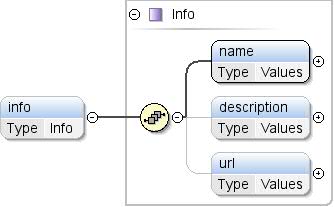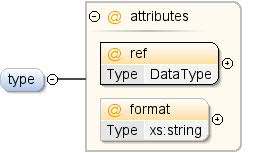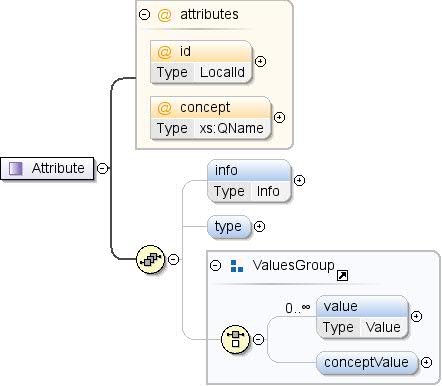Componente: atributo
Mantenha tudo organizado com as coleções
Salve e categorize o conteúdo com base nas suas preferências.
Elemento: atributo / informações
| Namespace |
http://schemas.google.com/dspl/2010 |
| Anotações |
Informações textuais sobre o atributo. |
| Diagrama |
 |
| Tipo |
Informação |
| Propriedades |
| content: |
complexo |
| minOcurs: |
0 |
|
| Modelo |
nome , descrição{0,1} , url{0,1} |
| Filhos |
descrição, nome, url |
| Instância |
<info>
<name>{1,1}</name>
<description>{0,1}</description>
<url>{0,1}</url>
</info>
|
| Origem |
<xs:element name="info" type="Info" minOccurs="0">
<xs:annotation>
<xs:documentation>Textual information about the attribute.</xs:documentation>
</xs:annotation>
</xs:element>
|
Elemento: atributo / tipo
| Namespace |
http://schemas.google.com/dspl/2010 |
| Anotações |
O tipo de dados do atributo. |
| Diagrama |
 |
| Propriedades |
| content: |
complexo |
| minOcurs: |
0 |
|
| Atributos |
| QName |
Tipo |
Fixo |
Padrão |
Usar |
Nota |
| formato |
xs:string |
|
|
opcional |
Um formato para o valor, usado para analisar uma resposta
representação dos valores. Consulte [Especificação de formatos de data] para
datas. |
| ref |
DataType |
|
|
obrigatório |
|
|
| Origem |
<xs:element name="type" minOccurs="0">
<xs:annotation>
<xs:documentation>The data type of the attribute.</xs:documentation>
</xs:annotation>
<xs:complexType>
<xs:attribute name="ref" type="DataType" use="required"/>
<xs:attribute name="format" type="xs:string" use="optional">
<xs:annotation>
<xs:documentation>A format for the value, used to parse a textual
representation of the values. See [Date formats spec]
for dates.</xs:documentation>
</xs:annotation>
</xs:attribute>
</xs:complexType>
</xs:element>
|
Tipo complexo: atributo
| Namespace |
http://schemas.google.com/dspl/2010 |
| Anotações |
Um atributo de um conjunto de dados ou conceito. |
| Diagrama |
 |
| Usados por |
|
| Modelo |
info{0,1} , tipo{0,1} , (valor*
| conceptValue{0,1}). |
| Filhos |
conceptValue, info, type,
valor |
| Atributos |
| QName |
Tipo |
Fixo |
Padrão |
Usar |
Nota |
| Conceito |
xs:QName |
|
|
opcional |
Uma referência a um conceito que corresponde aos valores
do atributo. Se o atributo especificar um tipo, então o tipo
precisa corresponder ao tipo do conceito referenciado. Uma referência a um
conceito externo precisa ter a forma
"prefix:other_concept_id", em que "prefix" é
o prefixo usado para o namespace do conjunto de dados externo (consulte XML
namespaces). |
| id |
LocalId |
|
|
opcional |
O ID do atributo de conceito. Esse identificador precisa ser
exclusivos dentro do conceito (em atributos e propriedades). A
id pode ser omitido se o atributo conceitual for especificado. Nesse
no caso, um ID é implicitamente criado com um valor igual ao nome local do
conceito referenciado. Por exemplo: <attribute
concept="unit:currency"/> é equivalente a
<attribute id="currency"
concept="unit:currency"/> |
|
| Origem |
<xs:complexType name="Attribute">
<xs:annotation>
<xs:documentation>An attribute of a dataset or a concept.</xs:documentation>
</xs:annotation>
<xs:sequence>
<xs:element name="info" type="Info" minOccurs="0">
<xs:annotation>
<xs:documentation>Textual information about the attribute.</xs:documentation>
</xs:annotation>
</xs:element>
<xs:element name="type" minOccurs="0">
<xs:annotation>
<xs:documentation>The data type of the attribute.</xs:documentation>
</xs:annotation>
<xs:complexType>
<xs:attribute name="ref" type="DataType" use="required"/>
<xs:attribute name="format" type="xs:string" use="optional">
<xs:annotation>
<xs:documentation>A format for the value, used to parse a textual
representation of the values. See [Date formats spec]
for dates.</xs:documentation>
</xs:annotation>
</xs:attribute>
</xs:complexType>
</xs:element>
<xs:group ref="ValuesGroup" minOccurs="0"/>
</xs:sequence>
<xs:attribute name="id" type="LocalId" use="optional">
<xs:annotation>
<xs:documentation>The id of the concept attribute. This identifier must be unique within the concept
(across attributes and properties).
The id may be omitted if the concept attribute is specified. In that case, an id is
implicity created with value the local name of the referenced concept. For instance
<attribute concept="unit:currency"/>
is equivalent to
<attribute id="currency" concept="unit:currency"/></xs:documentation>
</xs:annotation>
</xs:attribute>
<xs:attribute name="concept" type="xs:QName" use="optional">
<xs:annotation>
<xs:documentation>A reference to a concept that corresponds to the values of the attribute.
If the attribute specifies a type, then the type must match the type of
the referenced concept.
A reference to an external concept must be of the form "prefix:other_concept_id",
where "prefix" is the prefix used for the namespace of the external dataset
(see XML namespaces).</xs:documentation>
</xs:annotation>
</xs:attribute>
</xs:complexType>
|
| Namespace |
Nenhum namespace |
| Tipo |
DataType |
| Propriedades |
|
| Atributos |
| enumeração |
string |
|
| enumeração |
float |
|
| enumeração |
número inteiro |
|
| enumeração |
booleano |
|
| enumeração |
data |
|
| enumeração |
conceito |
|
|
| Usados por |
|
| Origem |
<xs:attribute name="ref" type="DataType" use="required"/>
|
| Namespace |
Nenhum namespace |
| Anotações |
Um formato para o valor, usado para analisar uma representação textual
dos valores. Consulte as datas na [Especificação de formatos de data]. |
| Tipo |
xs:string |
| Propriedades |
|
| Usados por |
|
| Origem |
<xs:attribute name="format" type="xs:string" use="optional">
<xs:annotation>
<xs:documentation>A format for the value, used to parse a textual
representation of the values. See [Date formats spec]
for dates.</xs:documentation>
</xs:annotation>
</xs:attribute>
|
| Namespace |
Nenhum namespace |
| Anotações |
O ID do atributo de conceito. Esse identificador precisa ser exclusivo
dentro do conceito (em atributos e propriedades). O ID pode ser
omitido se o atributo de conceito for especificado. Nesse caso, um ID é
a simplicidade foi criada com o valor do nome local do conceito referenciado.
Por exemplo: <attribute conceitua="unit:currency"/> é
equivalente a <attribute id="currency"
concept="unit:currency"/> |
| Tipo |
LocalId |
| Propriedades |
|
| Atributos |
|
| Usados por |
|
| Origem |
<xs:attribute name="id" type="LocalId" use="optional">
<xs:annotation>
<xs:documentation>The id of the concept attribute. This identifier must be unique within the concept
(across attributes and properties).
The id may be omitted if the concept attribute is specified. In that case, an id is
implicity created with value the local name of the referenced concept. For instance
<attribute concept="unit:currency"/>
is equivalent to
<attribute id="currency" concept="unit:currency"/></xs:documentation>
</xs:annotation>
</xs:attribute>
|
Atributo: Atributo / @concept
| Namespace |
Nenhum namespace |
| Anotações |
Uma referência a um conceito que corresponde aos valores do
. Se o atributo especificar um tipo, esse tipo deve corresponder
o tipo do conceito referenciado. uma referência a um conceito externo
deve estar no formato "prefix:other_concept_id", em que
"prefixo" é o prefixo usado para o namespace do namespace
conjunto de dados (consulte Namespaces XML). |
| Tipo |
xs:QName |
| Propriedades |
|
| Usados por |
|
| Origem |
<xs:attribute name="concept" type="xs:QName" use="optional">
<xs:annotation>
<xs:documentation>A reference to a concept that corresponds to the values of the attribute.
If the attribute specifies a type, then the type must match the type of
the referenced concept.
A reference to an external concept must be of the form "prefix:other_concept_id",
where "prefix" is the prefix used for the namespace of the external dataset
(see XML namespaces).</xs:documentation>
</xs:annotation>
</xs:attribute>
|
Criado usando o
Editor XML oXygen.
Exceto em caso de indicação contrária, o conteúdo desta página é licenciado de acordo com a Licença de atribuição 4.0 do Creative Commons, e as amostras de código são licenciadas de acordo com a Licença Apache 2.0. Para mais detalhes, consulte as políticas do site do Google Developers. Java é uma marca registrada da Oracle e/ou afiliadas.
Última atualização 2025-07-25 UTC.
[[["Fácil de entender","easyToUnderstand","thumb-up"],["Meu problema foi resolvido","solvedMyProblem","thumb-up"],["Outro","otherUp","thumb-up"]],[["Não contém as informações de que eu preciso","missingTheInformationINeed","thumb-down"],["Muito complicado / etapas demais","tooComplicatedTooManySteps","thumb-down"],["Desatualizado","outOfDate","thumb-down"],["Problema na tradução","translationIssue","thumb-down"],["Problema com as amostras / o código","samplesCodeIssue","thumb-down"],["Outro","otherDown","thumb-down"]],["Última atualização 2025-07-25 UTC."],[],["The core content describes the structure and properties of an \"Attribute\" within a dataset or concept. An attribute can include optional textual information (`info`), its data `type` (required), and value. The `type` specifies the data type and can have a `format`. Attributes have an optional `id` for unique identification and can refer to another `concept`. The `info` section may include name, description, and URL.\n"]]



